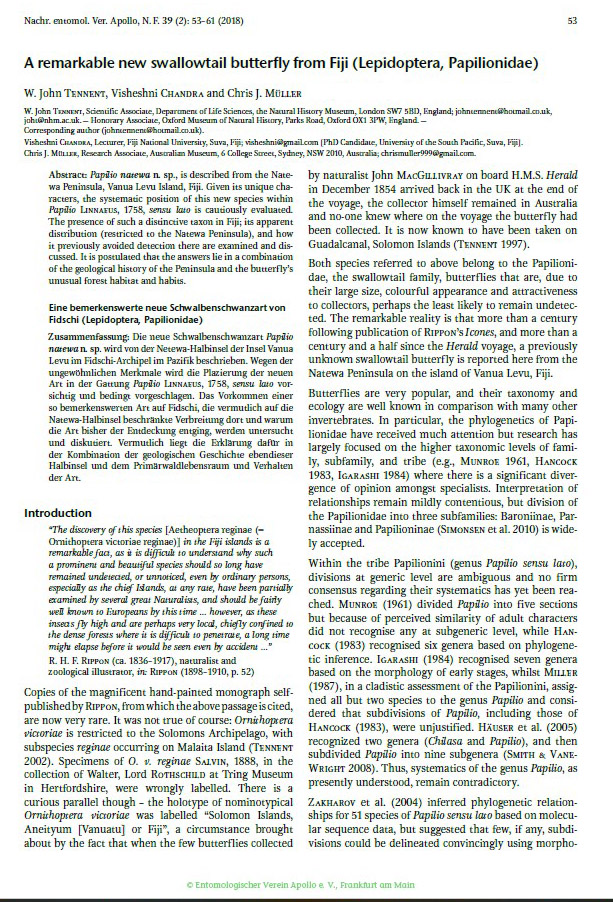Human nature complexities – Collectors, economics and biodiversity in Fiji and Australia
In 2017 and 2018 I spent eight weeks working as part of a small team of scientists to carry out the first baseline flora and fauna surveys on a project aiming to establish the first large National Park in Fiji. While reptile and amphibian numbers were low (due to mongoose predation; see previous post), birds fared better, and a new species of butterfly was identified.
The recent description of this new swallowtail butterfly species for Fiji (Tennent et al. 2018, Figure 1) has created an international stir in the world of butterflies. The presence of such a distinct, large and attractive species, the question of why it wasn’t previously detected and the reasons for its restricted distribution are fascinating. This interest underpins an important step towards the ultimate objective of facilitating the local Fijian community in obtaining economic benefit from developing Fiji’s first large National Park. The potential for ecotourism increased with the discovery of this attractive species, potentially helping the community to run an effective guide program and associated supporting industries. And indeed within a month of the publication of the paper, tourists from across the world were in Fiji to see this new butterfly. But, the excitement of taking a picture that has lead to the description of this new species (Figure 2) must now be tempered with new challenges. A species of such significance that it attracts tourists to a remote Fijian Peninsula brings unintended threats.
The worldwide trade in butterflies is big business, with individuals of some species worth many thousands of dollars. For many species this trade is the very heart of biodiversity conservation and sustainable development. It can provide an income for some of the world’s least economically affluent people and it generates considerable revenue. In Asia the unsustainable trade in wildlife has been identified as one of the main conservation challenges. Internationally, wildlife trade is regulated through the Convention on International Trade in Endangered Species of wild fauna and flora (CITES). Between 1998 and 2007, international trade in CITES-listed animals was estimated to be 35 million animals (Nijman 2010). This includes 0.3 million butterflies, 16.0 million seahorses, 0.1 million other fish, 17.4 million reptiles, 0.4 million mammals, and 1.0 million birds; the vast majority – 30 million (300 species) – being wild-caught. With regards to butterflies, during the 1980s, 80% of the world’s swallowtail species were made available through international trading organisations, but less than 10% were farmed or ranched (Collins and Morris 1985). The remaining species being wild caught.
Some collectors will go to great lengths to obtain rarities, for their own collections or for sale at a profit. More recently the rise of butterfly houses, which often display exotic species in artificial jungles has created a demand for a constant supply of living swallowtail specimens for display.
A few weeks after publication of the species description, the discovery by local villagers of a collector with 12 swallowtail specimens on the Natewa Peninsula gave warning to the looming threat. The Vusaratu Yaubula Committee, which manages the local natural resources, was very much concerned with what transpired. To stop this practice they have put in place a protocol to be followed by the villagers, tour guides and the visitors before butterfly watchers are approved to enter the forest. Within a week, collectors from New Zealand, Japan and China were seeking guides from the local mataqali (Fijian clan group) to show them the swallowtail species. The community has indicated they have zero tolerance with any individual or group who wishes to collect butterflies. Consequently, three Japanese collectors were turned away because they wanted to collect the butterfly.
As with most threatened swallowtail butterflies P. natewa is characterised by narrow niche breadth, restricted resource distribution, and poor dispersal ability (Collins and Morris 1985). Fending off the collectors while facilitating the thousands more who want to see such a unique and rare species, in a sustainable manner, is now the challenge. But, for the local relatively impoverished community, it will take strong wills to balance the conflict between short-term gains promised by collectors against the long-term benefit of sustainable ecotourism.
Back in our neck of the woods at Walker Swamp, amateur and professional firewood collectors are also presenting a challenge to local diversity. Construction of a boundary fence and locked gates has allowed control of firewood extraction within the Walker Swamp Restoration Reserve (WSRR), but the impact on river red gum communities continues unabated in the adjacent Grampians National Park. Extraction of river red gum for firewood presents a significant threat to local biodiversity through habitat simplification. Across Victoria the legislation and regulations that establish the rules for domestic firewood collection are in the: Forests Act 1958; Forests (Domestic Firewood) Regulations 2012; Crown Land (Reserves) Act 1978; and Crown Land (Reserves) (Domestic Firewood) Regulations 2010. Designated areas for legal firewood extraction are identified each year. Despite there being heavy penalties for not complying with these rules, including fines of up to 50 penalty units (current value of the maximum fine is $7,928.50) or one year imprisonment, illegal firewood extraction continues.
Within the WSRR removal of blue gums has provided a significant sustainable firewood resource. But, how to make this available for extraction? Public liability and oversight of extraction present significant risks and costs. Recently we have identified a local operator with appropriate insurance who is aiming to provide a sustainable source of firewood extracted from plantation timbers. A good solution all round.
References:
Collins, M.W. & M.G. Morris (1985) Threatened Swallowtail Butterflies of the World. The IUCN Red Data Book. IUCN, Gland and Cambridge. https://portals.iucn.org/library/sites/library/files/documents/RD-1985-002.pdf
Tennent, W. J., V. Chandra, & C. J. Muller (2018) A remarkable new swallowtail butterfly from Fiji (Lepidoptera, Papilionidae). Nachr. entomol. Ver. Apollo, N. F. 39 (2): 53–61


